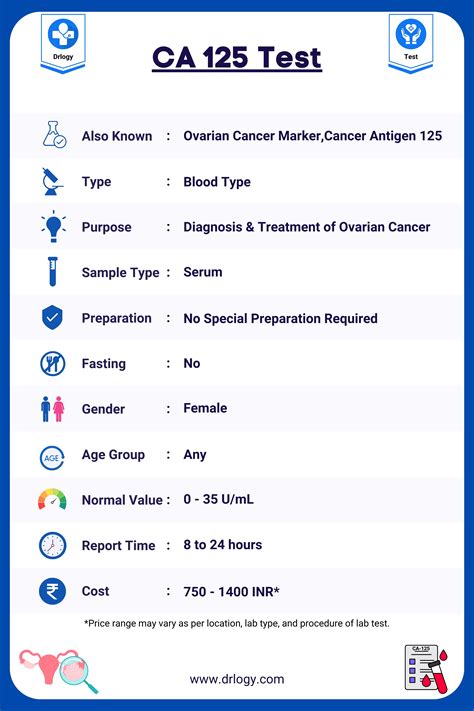The CA 125 test, also known as the cancer antigen 125 test, is a blood test used primarily to monitor and track the progression of ovarian cancer in women. It measures the level of the protein CA 125 in the blood, which can be elevated in women with ovarian cancer. While not exclusively a diagnostic tool due to its lack of specificity and sensitivity for early-stage ovarian cancer, the CA 125 test plays a significant role in managing treatment and assessing the health progress of patients undergoing therapy for ovarian cancer.
Understanding CA 125
CA 125 is a protein that can be found in the blood. It is produced by some ovarian cancer cells, and its levels can increase when ovarian cancer is present. However, elevated CA 125 levels can also be associated with other conditions, such as endometriosis, uterine fibroids, and even normal physiological processes like menstruation. This nonspecificity means that the CA 125 test cannot be relied upon as the sole diagnostic tool for ovarian cancer. Instead, it is used as part of a comprehensive diagnostic workup that includes physical exams, imaging studies (like ultrasound and CT scans), and sometimes surgical evaluation.
Role in Monitoring Treatment
For patients diagnosed with ovarian cancer, the CA 125 test becomes an important tool for monitoring the effectiveness of treatment and tracking the progression of the disease. Here are some ways the CA 125 test is used:
Assessing Response to Treatment: After initiating treatment, such as chemotherapy or surgery, the CA 125 levels can indicate how well the treatment is working. A decrease in CA 125 levels often suggests that the treatment is effective, while stable or increasing levels may indicate a poorer response to treatment.
Detecting Recurrence: In patients who have undergone successful treatment and are in remission, regular CA 125 tests can help detect if the cancer has returned. An increase in CA 125 levels over time can be an early sign of recurrence, prompting further investigation and potentially earlier intervention.
Guiding Treatment Decisions: The results from CA 125 tests can influence decisions about continuing, changing, or stopping treatment. For example, if CA 125 levels indicate that the cancer is not responding to the current treatment, the healthcare provider might consider alternative treatments.
Interpreting CA 125 Test Results
Interpreting the results of a CA 125 test requires careful consideration of the individual patient’s context, including their medical history, current symptoms, and the results of other diagnostic tests. Here are some key points to understand:
Normal Levels: Generally, CA 125 levels below 35 units per milliliter (U/mL) are considered normal. However, what is considered a “normal” level can vary slightly between different laboratories.
Elevated Levels: Levels above 35 U/mL can be associated with ovarian cancer but also with many other conditions, as mentioned earlier. The significance of an elevated CA 125 level is interpreted in conjunction with other diagnostic findings.
Serial Measurements: Rather than a single measurement, tracking changes in CA 125 levels over time is more informative. A rising trend can be more concerning than a single elevated measurement.
Limitations and Future Directions
While the CA 125 test is a valuable tool in the management of ovarian cancer, it has several limitations. Its lack of specificity means it cannot be used for screening the general population for ovarian cancer. Research is ongoing to identify more specific biomarkers for ovarian cancer that could lead to earlier detection and improved outcomes.
Conclusion
The CA 125 test is an essential component of ovarian cancer management, offering healthcare providers a means to monitor treatment response and track the progression of the disease. By understanding the role of the CA 125 test and its limitations, patients and healthcare providers can work together to make informed decisions about care and improve health outcomes for those affected by ovarian cancer.
FAQs
What is the CA 125 test used for?
+The CA 125 test is primarily used to monitor ovarian cancer treatment and track the health progress of patients undergoing therapy. It measures the level of the protein CA 125 in the blood, which can be elevated in women with ovarian cancer.
Can the CA 125 test diagnose ovarian cancer?
+No, the CA 125 test is not used as a diagnostic tool for ovarian cancer due to its lack of specificity. Elevated CA 125 levels can be associated with various conditions other than ovarian cancer. Diagnosis involves a comprehensive approach including physical exams, imaging studies, and sometimes surgical evaluation.
How often should the CA 125 test be performed for monitoring ovarian cancer treatment?
+The frequency of CA 125 testing for monitoring ovarian cancer treatment is determined by the healthcare provider based on the individual patient’s situation, including the stage of cancer, response to treatment, and overall health status. Regular testing can help in early detection of recurrence and in assessing treatment efficacy.



